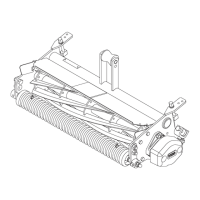Greensmaster 3250--D Hydraulic SystemPage 4 -- 1 5
Raise and Lower Cutting Units
The tandem gear pump is directly coupled to the piston
(traction) pump. The rear gear pump section supplies
hydraulic flow for the steering circuit (priority flow), for
raisingandloweringthecuttingunits andforthetraction
charge circuit. The gear pump takes its suction from the
hydraulic reservoir. Maximum circuit pressure of 1160
PSI (80 bar) is limited by the relief valve located in the
steering valve.
During cutting unit hold (not raising or lowering) condi-
tions, flow from the gear pump (P2) is by--passed
through the steering valve and de--energized solenoid
valve (S2) in the hydraulic manifold directly to the trac-
tion charge circuit. Flow in excess of charge circuit re-
quirements then returns to the gear pump inlet.
Raise Cutting Units
When the cutting units are to be raised, solenoid valve
(S2) is energized and blocks flow directly to the traction
charge circuit. Flow is directed to energized solenoid
valve (S3), which directs flow to de--energized solenoid
valve (S4) and the lift cylinders. Hydraulic pressure
against the cylinder pistons moves t heir shafts causing
the cutting units to raise. At the same time, the pistons
push the hydraulic fluid out o f the lift cylinders and back
throughenergizedsolenoidvalve( S3) to the chargecir-
cuit. Raise speed for the front cutting units is controlled
bya0.055orifice.A0.055orificeinthereturnlineforthe
centercuttingunitallowsaslightdelayinraisingthatcut-
ting unit.
When solenoid valves (S2) and (S3) de--energize,
spring action returns the valves to their original position
and by--passes flow back to the traction charge circuit
stoppingliftcylindermovement.Theliftcylinderposition
is locked in place since there is no complete circuit of
flow to and from the lift cylinders.
Lower Cutting Units
Circuit operation for lowering the lift cylinders is similar
to raising them. However, the solenoid valve (S3) re-
mains de--energized and solenoid valve (S4) is ener-
gized. Flow is reversed to and from the lift cylinders,
lowering the cutting units.
Whenthe cuttingunits aretobelowered,solenoidvalve
(S2) is energized and blocks flow directly to the traction
charge circuit. Flow is directed to de--energized sole-
noid valve (S3), which directs flow to the lift cylinders.
Hydraulic pressure against the cylinder pistons moves
their shafts causing the cutting units to lower. At the
sametime,thepistonspushthehydraulicfluidoutofthe
liftcylinderstoenergizedsolenoidvalve(S4). Flowcon-
tinues back through de--energized solenoid valve (S3)
to the charge circuit. Lower speed for the front cutting
units is controlled by the 0.055 orifice. A 0.055 orifice
and adjustable flow control valve for the center cutting
unit allows a slight delay in lo wering that cutting unit.
To control pressure while lowering the cutting units, the
system is equipped with adjustable relief valve (R2) in
the hydraulic manifold.
When solenoid valves (S2) and (S4) de--energize,
spring action returns the valves to their original position
and by--passes flow back to the traction charge circuit
stopping lift cylinder movement.
Hydraulic
System

